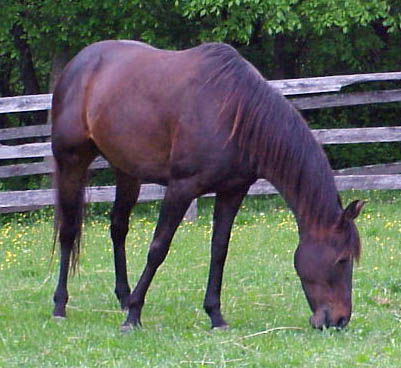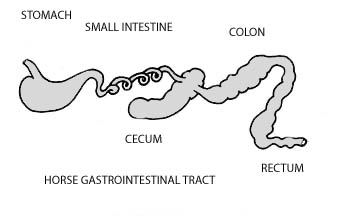The Horse's Digestive System

|

|
Nature is a fantastic engineer and solver of problems. Ask any plant and it will tell you that its biggest frustration is that as soon as it grows even the slightest bit something always seems to come along and eat it. In the plant kingdom’s continuing quest for a champion that no animal could successfully eat, it came up with grasses. Grasses are tough and fibrous and very hard for animals to digest. As a kid you might have chewed on some but we humans and many other types of animals cannot digest it and have no interest in it as a foodstuff. Once the plant kingdom came up with grasses the animal kingdom came up with animals that are capable of digesting grass and the horse was among them. As far as a horse is concerned it is all about eating grass and they spend an inordinate amount of time with their heads down on the ground eating grass. They crave grass and nothing makes them happier than being turned out on a nice fresh pasture in the spring. A wild horse will graze up to 18-20 hours a day while domesticated horses average about 9-14 hours. During that time the average horse consumes about 30 pounds (dry weight) of forage.

Nature solves its problems in different ways. Both horses and cattle are designed to eat grass but their digestive systems are engineered very differently. In cattle the various stomachs occupy about 70% of the total volume of the digestive tract and function as fermentation vats to allow bacteria to help with the difficult to digest grass. Horses began their evolutionary careers as browsing animals and retained a basic stomach that is rather similar to humans and one that occupies only about 10% of the volume of their digestive tract. Plant material enters the stomach which then churns it up and releases it in small regular amounts that will not overwhelm downstream processing. Digestion begins in the stomach but much of a horse’s diet consists of things that are not digested in the stomach. The acid environment of the stomach also helps protect a ground feeding animal from bacteria and other living organism that might be picked up with feed and glass. The various parasites horses are subject to have devised strategies to survive passage through the stomach.
The small intestine of a horse is 50 to 70 feet long. That is much longer than that of humans, which is 23 feet long. Another difference between humans and horses is that horses do not have a gall bladder. In humans bile, made by the liver, enters the first part of the small intestines through a small nipple in response to eating a meal. Since horses graze almost continually they have no need for an organ that functions as a reservoir for bile and nature has let it go. The small intestines are a disassembly line. The upper part is devoted to breaking down food into its more simple constituents and the lower part then absorbs it through the wall of the intestine into the blood stream. Digestion of food stuff is accomplished by enzymes, most of which come from the pancreas. Digestive enzymes are a neat trick because the body must be careful not to digest itself. When it does we have what we know of as ulcers and under certain circumstances horses can get them.
Up to this point the horse’s digestive tract is fairly similar to that of most other creatures and where that the end of the story we would not have horses living today. The true secret weapon that the horse developed, and that puts it on a par with the stomach of cattle, is its large intestines (hindgut) and specifically its cecum. Both horses and humans have a structure in their bowels called a cecum but they are not the same thing. What we call the cecum in the horse is the same structure as the appendix in humans. Unlike man the horse appendix (cecum) is an organ critical to horses’ survival as a species.
The equine cecum is 4 feet long and holds as much as eight gallons of material. When we look at a horse we believe that we are seeing a single living thing but in truth we are looking at only the largest member and the container of what in fact is a community of living things and here is another scary thought: look in the mirror and the same can be said for what is looking back at you. What I am speaking of is millions of bacteria living in the intestines of both humans and horses. We grow up thinking that all bacteria are bad and that they are primitive one cell organisms of no account. It is true no bacteria has yet to compose a symphony but on the other hand they have developed biochemical mechanisms that are the wonder of nature and digestive capabilities totally unknown to so called higher creatures. What the horse has done is partner with bacteria that are capable of digesting plant material that the horse cannot and these germs live in peace in the horse’s cecum. Material passes into the cecum and sits there for about 7 hours fermenting and the horse and the bacteria split the proceeds. The horse receives volatile fatty acids and a certain amount of heat from the bacterial digestion, which helps keep it warm in the winter. This explains why proper forage is so essential to keep horses warm in the winter.
Once the cecum is finished the material enters the horse’s colon and the finial adsorption of the digested material takes place along with the removal of water and electrolytes. The more solid material leaving by the anus is the remains of plant material that did not break down during the digestive process and some of the bacteria that went with the flow. I did present a brief discussion of manure management on another page.